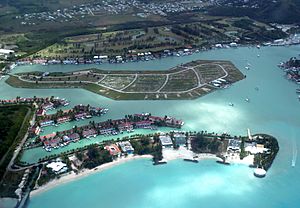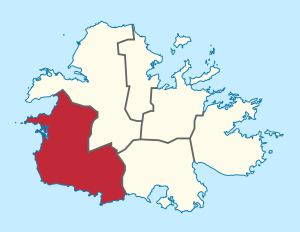Saint Mary, Antigua and Barbuda facts for kids
Quick facts for kids
Parish of Saint Mary
|
|
|---|---|

Aerial view of Harbour Island in Jolly Harbour, located in the parish.
|
|
 |
|
| Country | Antigua and Barbuda |
| Established | 11 January 1692 |
| Capital | Old Road |
| Population
(2018)
|
|
| • Total | 8,141 |
| Time zone | UTC-4 (AST) |
The Parish of Saint Mary is a special area in Antigua and Barbuda, located on the island of Antigua. It shares borders with Saint John to the north and Saint Paul to the east.
Saint Mary is mostly covered by the Shekerley Mountains. Its northern edge follows these mountains and a waterway called Cooks Creek. The biggest town in the parish is Bolands, which includes the Jolly Harbour area. The main church for the parish is in Old Road.
Saint Mary was created on January 11, 1692, along with five other original parishes. In 2011, about 7,341 people lived here, and by 2018, the population grew to 8,141. This parish is part of the "Pineapple Belt," the only place where the famous Antigua black pineapple can grow.
Contents
History of Saint Mary
The Antigua Black Pineapple is known as the sweetest pineapple in the world. It grows mostly in Saint Mary and Saint Paul. This is because the area has special rainfall patterns and a long history of farming.
Sugar Plantations and Their Legacy
For many years, Saint Mary was home to several sugar plantations. These large farms grew sugarcane, which was processed into sugar. Many people were forced to work on these plantations.
The remains of old sugar mills can still be found in various parts of the parish. These mills were once busy places where sugarcane was crushed.
Life on the Plantations
Life on the plantations was very difficult for the enslaved people. They worked long hours in harsh conditions. Records show that many people were forced to live and work on these estates.
Some plantations had special buildings called "dungeons." These were small, strong stone rooms built into rocks. They were used to hold people who were considered disobedient. Today, only a few of these "dungeons" still exist. They are important historical sites.
After slavery ended, some of these lands were divided. They became available for former enslaved people or free people of color to buy. This was a big step towards freedom and owning land.
Notable Plantations
Many plantations existed in Saint Mary. Here are a few examples:
- Blubber Valley & Mosquito Cove: This area once had large plantations. Records show many people were forced to work here.
- Brook's: The old estate house ruins can still be seen. A large stone building, once used to store cotton, became a community center for dances.
- Christian Valley / Biffins: This area has old stories about strange lights. People believed these lights tried to protect the original plantation owner.
- Claremont: The estate house is still in the mountains with amazing views. It was once owned by important figures like the Duke of Newcastle and Queen Victoria. Today, it's one of the places where the Antigua Black Pineapple is grown.
- Douglas’s Estate – Ravenscroft: This estate was known for its spring, which provided drinking water. Ships would even come to collect water from it.
- Ffry’s: This area had two mills. One is now part of a park with vacation cottages.
- Green Castle: This was a very large and important plantation. The owner, Col. Samuel Martin, tried new farming methods. He believed in treating the enslaved people well, providing food and clothing.
- Hermitage: This area is now a fancy residential neighborhood. An old mill can still be seen from the beach. After slavery ended, Moses Francis, one of Antigua's first black landowners, bought this land.
- Jolly Hill: The old estate house still stands with a great view of Jolly Harbour. There is a small cemetery with old grave markers.
- Mill Hill: This area was important for its water supply. Water from springs here was piped to the capital city, St. John's.
- Montero's: The mill is still in good condition on a hill. This area was once owned by a large merchant family from Liverpool.
- Morris’: This area has beautiful sea views. The Curtain Bluff Hotel is located here. A new resort is being built on part of the old estate land.
- New Division: This estate was known for its beautiful location with views of the "Sleeping Indian" mountains.
- Orange Valley: This area has a well-preserved "dungeon" building. The beach nearby, Dead Sands (Darkwood), has changed over time due to sand movement.
- Picard’s: Not much is known about this estate. It is now being developed into homes.
- Rigby's: This mill is unique because it has "striped" stones.
- Sage Hill: This area is famous for Tom Moore's Spring, a valuable water source.
- Sawcolt’s: The mill here is made of black volcanic stone. This area was also a source of water for St. John's.
- Seaforth’s: This estate switched to steam power in the mid-1800s. It is now being developed for tourism.
- Smith's: This is one of the few working estates left, raising cattle, sheep, and goats.
- Tranquil Vale: This estate is near the village of Bolans.
- Tremontaine / The Mountain: The mill here can still be seen from Fig Tree Drive. It was once owned by the Williams family.
- Tuck’s / Farley Bay: Little is known about this plantation.
- Willock’s: This estate has old copper pots used for water. It is still used for raising livestock and has many fruit trees.
- Yorke’s: This estate was once combined with "Muskito Cove." It was known for having the first bank and gallows in Antigua.
- Young’s / Nanton’s: The mill here is in good condition. The number of enslaved people on this estate decreased over time.
Geography of Saint Mary
The highest point in Saint Mary, and in all of Antigua and Barbuda, is Boggy Peak. It was renamed Mount Obama. Since the Shekerley Mountains cover most of the parish, many people live in the flatter northern parts or along the coast. This includes the capital city, Bolands.
Education in Saint Mary
In 2011, about 1,679 young people in Saint Mary were attending school full-time. This means that over a quarter of the parish's population was of school age.
Population Information
In 2011, about 2.74% of the people in Saint Mary had experienced some type of crime. Half of these crimes were housebreaking. About 79% of homes had cable TV, but only 33% had internet access. Saint Mary has one of the lowest rates of crowded homes in the country. Also, only a small percentage of people, about 2.60%, have a disability. The parish is home to many immigrants, with about 22.8% of the population being from other countries.
Towns and Areas in Saint Mary
- Bolands-Jolly Harbour
- Bishops
- Tre' Philip
- Cades Bay
- Cedar Hall
- Claremont
- Crabs Hill
- Ebenezer
- Glebe
- Jennings
- John Hughes
- Johnsons Point
- New Division
- Old Road
- Orange Valley Mill
- Sawcolts
- Seaforths
- Urlings
- Yorks
Famous People from Saint Mary
- Hamish Anthony - A talented cricketer.
- James Carlisle - The second Governor-General of the country.
- George Ferris - Another skilled cricketer.
- Gayson Gregory - A well-known football player.
- Andy Roberts - A famous cricketer.
- Joseph Matthew Sebastian - A leader in Caribbean trade unions and a member of the Legislative Council of Saint Kitts-Nevis-Anguilla.
- Janiel Simon - A football player.
- Gavin Williams - A cricketer.
See also
 In Spanish: Parroquia de Saint Mary (Antigua y Barbuda) para niños
In Spanish: Parroquia de Saint Mary (Antigua y Barbuda) para niños

